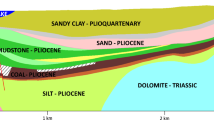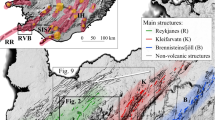Abstract
A coal mine panel claimed to infringe on a permit boundary, or to create an hazard after subsidence has been the subject of lawsuits. We study at the Soma–Darkale coalfield (Manisa, Turkey), the footprint of a lignite coal mine panel at a depth of about 150–200 m by mapping all of the surface fractures we could observe, and by developing a post-subsidence density model that we verified through gravity measurements with positive Bouguer anomaly. With the analysis of the fracture map and the gravity data, we were able to identify the footprint of a mine panel from the effect of the anomalous mass due to denser overburden material filling up the space after the extraction of less-dense lignite. Whereas, using empirical methods like the so-called “limit line approach” to evaluate the extent of the area where mining can have subsidence-induced surface fracturing, one could not recognize for certain infringement of permit boundaries. The orientations of the fractures we mapped at the ground surface, the Bouguer gravity map, and a test borehole indicated the presence and dimensions of a coal panel in dispute. The presented approach based on gravity method and fracture observations may be an example to help settle conflicts related to the position of the longwall mine panel.







Similar content being viewed by others
References
Aksoy CO, Kose H, Onargan T, Koca Y, Heasley K (2004) Estimation of limit angle using laminated displacement discontinuity analysis in the Soma coal field, Western Turkey. Int J Rock Mech Min Sci 41:547–556
Annecchione MA, Chouteau M, Keating P (2001) Gravity interpretation of bedrock topography: the case of the Oak Ridges Moraine, Southern Ontario, Canada. J Appl Geophys 47:63–81
Booth CJ (2003) Groundwater as an environmental constraint of longwall coal mining. RMZ Materials Geoenviron 50:49–52
Booth CJ (2006) Groundwater as an environmental constraint of longwall coal mining. Environ Geol 49:796–803
Booth CJ, Spande ED (1992) Potentiometric and aquifer property changes above subsiding longwall mine panels, Illinois Basin Coalfield. Ground Water 30:362–368
Brouwer J, Nijhof V (1994) The use of geophysical techniques for detection of—partially collapsed—mine shafts. In: Proceedings of the Symposium on the Application of Geophysics to Engineering and Environmental Problems, March 27–31, Boston, MA, pp 593–604
Debeglia N, Dupont F (2002) Some critical factors for engineering and environmental microgravity investigations. J Appl Geophys 50:435–452
Dobrin MB, Savit CH (1988) Introduction to geophysical prospecting, 4th edn. McGraw Hill Book Co., New York, p 867
Dunrud CR (1984) Coal mine subsidence—western United States, in Geological Society of America Reviews in Engineering Geology. Vol. V1, 151—194
Fenning PJ, Brown AJ, Nind D (2000) Geophysical survey across a ground subsidence feature. In: Proceedings of the Symposium on the Application of Geophysics to Engineering and Environmental Problems, February 20–24, Arlington, VA, pp 857–866
Franks CAM, Geddes JD (1986) Subsidence on steep slopes due to longwall mining. Int J Mining Geol Eng 4:291–301
Gabriel G, Kirsch R, Siemon B, Wiederhold H (2003) Geophysical investigations of buried Pleistocene subglacial valleys in North Germany. J Appl Geophys 53:159–180
Inci U (2002) Depositional evolution of Miocene coal successions in the Soma coalfield, western Turkey. Int J Coal Geol 51:1–29
Karaman A, Carpenter PJ (1997) Fracture density estimates in glaciogenic deposits from P-wave velocity reductions. Geophysics 62:138–148
Karaman A, Akhiev SA, Carpenter PJ (1999) A new method of analysis of water-level response to a moving boundary of a longwall mine. Water Resour Res 35:1001–1010
Karaman A, Carpenter PJ, Booth CJ (2001) Type-curve analysis of water-level changes induced by a longwall mine. Environ Geol 7:897–901
Kim KD, Lee S, Oh HJ (2009) Prediction of ground subsidence in Samcheok City, Korea using artificial neural networks and GIS. Environ Geol 58:61–70
Koçyiğit A (1984) Intraplate neotectonic development in south-western Turkey and adjacent areas. Turkiye Jeoloji Bülteni 27:1–16 (in Turkish)
Roth MJS, Nyquist JE, Guzas B (2000) Locating subsurface voids in karst: a comparison of multi-electrode earth resistivity testing and gravity testing. In: Proceedings of the Symposium on the Application of Geophysics to Engineering and Environmental Problems, February 20–24, Arlington, VA, pp 359–365
Silva JBC, Teixeira WA, Barbosa VCF (2009) Gravity data as a tool for landfill study. Environ Geol 57:749–757
Wise DJ, Cassidy J, Locke CA (2003) Geophysical imaging of the Quaternary Wairoa North Fault, New Zealand: a case study. J Appl Geophys 53:1–16
Wolfe PJ, Richard BH, Hauser EC, Hicks JD (2000) Identifying potential collapse zones under highways. In: Proceedings of the Symposium on the Application of Geophysics to Engineering and Environmental Problems, February 20–24, Arlington, VA, pp 351–358
Acknowledgments
Turkish Coal Enterprise (TKI) and TKI Aegean Branch (ELİ) provided the grant. Hakkı Duran pushed forward for the project, Recep Çetiner skillfully organized ELİ resources, Karabekir Şengun carried out the legal inquiries. Ahmet Dertsiz, Kenan Kocatürk, and Serkan Alagöz helped for the field measurements.
Author information
Authors and Affiliations
Corresponding author
Rights and permissions
About this article
Cite this article
Karaman, A., Seyhan, T. & Işık, M.F. Detecting the footprint of a longwall mine panel claimed to infringe on a permit boundary at the Soma–Darkale coalfield (Manisa, Turkey) using surface fractures and microgravity measurements. Environ Earth Sci 70, 1895–1902 (2013). https://doi.org/10.1007/s12665-013-2277-3
Received:
Accepted:
Published:
Issue Date:
DOI: https://doi.org/10.1007/s12665-013-2277-3




